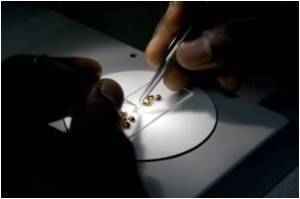A new study indicates that by sticking a chemical group to it at a specific site, a protein arrests an enzyme that may worsen and spread cancer.

"EZH2 is overexpressed in aggressive solid tumors and tied to cancer progression and metastasis," said the paper's senior author, Mien-Chie Hung, Ph.D., professor and chair of MD Anderson's Department of Molecular and Cellular Oncology. "We have found that another protein, CDK1, deactivates EZH2."
The team's basic research findings provide a rationale for developing an EZH2 inhibitor or a drug that mimics the protein that deactivates it as new cancer drugs. "You have to understand the molecular details of cancer formation and progression to develop new therapies that improve treatment and prevention," Hung said.
In a series of experiments, the team demonstrated how CDK1 interferes with EZH2, reducing cell migration and invasion in breast cancer cell lines.
EZH2 silences gene expression by attaching a methyl group, which consists of one carbon and three hydrogen atoms, to a histone protein that is intertwined with DNA and other proteins to compose chromosomes. Genes suppressed by this methylation include tumor suppressors that would otherwise prevent cancer growth and spread.
The team showed that CDK1 short-circuits EZH2-mediated methylation by attaching a different chemical group consisting of one phosphate and three oxygen atoms to EZH2, a process called phosphorylation. And that phosphorylation has to occur at a specific amino acid on EZH2 to have this effect.
Advertisement
Cancer cells with EZH2 that had a mutant version of the location where the phosphate group connects, preventing phosphorylation, had double the cell migration and invasion of cancer cells with the regular, unmutated version of EZH2.
Advertisement
EZH2 plays an important normal role in a variety of biological processes. "EZH2 is crucial to embryonic development because it turns genes off and on to guide the differentiation of embryonic stem cells into tissues and organs," Hung said. Embryonic stem cells can turn into any type of cell.
In a separate set of experiments, the researchers demonstrated that phosphorylation of EZH2 is necessary to the production of bone cells (osteoblasts).
Mesenchymal stem cells can differentiate into bone, cartilage or fat cells. The team showed only those cells with EZH2 phosphorylated by CDK1 differentiated into bone cells. Genes crucial to bone formation were silenced by methlyation but awakened when CDK1 altered EZH2.
A genomewide screen to identify genes targeted by EZH2 in mesenchymal stem cells was conducted before and after the cells differentiated into bone cells. Before, more than 4,000 genes were found to bind to EZH2. After differentiation to bone cells, 30 or fewer genes bound to the protein.
"This and other recently reported studies open up drug development possibilities by either inhibiting the methyltransferase activity of EZH2 or regulating phosphorylation to indirectly regulate EZH2's activity," Hung said.
"This study also suggests a possible way to induce mesenchymal stem cell differentiation into bone cells, which may have long-term implications for regenerative medicine for bone disease," Hung said.
Source-Eurekalert















